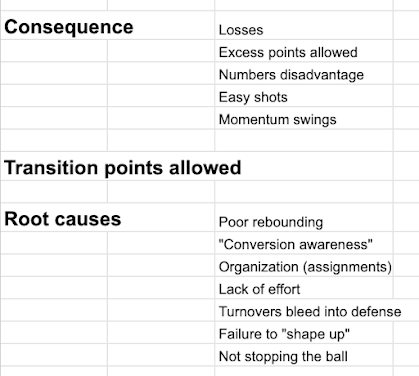Defining problems allows us to invoke specific solutions. In Nobel Laureate Malala Yousafzai's MasterClass, she shares the Problem-Tree exercise.
Enumerate our 'central problems' and assess root cause and consequences.
In an example, her guest discusses childhood obesity and consequences including low self-esteem, Type 2 diabetes, and excess national healthcare costs.
Common examples we encounter in basketball include:
- Turnovers
- Ball containment
- Shot selection
- Transition defense
- Pick-and-roll defense
Players learn in different ways. Part of our "feedback-rich" solution means testing and monitoring results. "We get what we accept." When players know that actions have consequences, they are more likely to change behaviors.
Tailor practice to reduce the root causes (e.g. inability to handle pressure) by playing 5 versus 7 or other advantage-disadvantage exercises.
Another example, use a spreadsheet shortcut...
Implement SMART followup of teaching.
S = specific "We expect turnovers to decline." Tracking reduced turnovers.
M = measurable
A = achievable Turnovers will never go to zero.
R = relevant Turnovers are one of the "Four Factors" outcome definers
T = timely It's too late to implement surveillance the last week of the season.
At the middle school level, we reported statistics for the team, not for individuals. We avoided singling out individual girls as turnover-prone or taking low quality shots.
Defining a handful of problems (e.g. six) and asking team members (pairs) to develop problem trees might have educational (production) value.
The method is flexible and applies to issues like grades. Ask players what root causes contribute to lower grades and what the consequences might be (lack of admission to desired schools). We've had players whom coaches said were not academic considerations for their schools.
Lagniappe. We call the three-point line the "spacing line."
Lagniappe 2. Finding work-life balance is an endless challenge.



